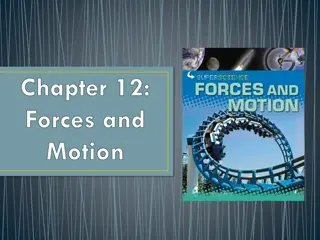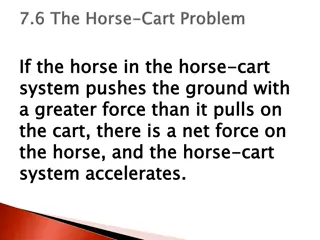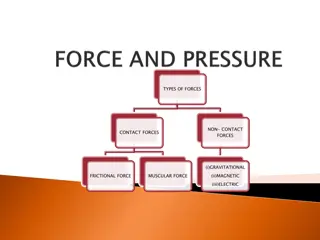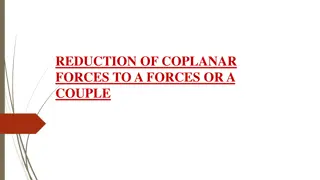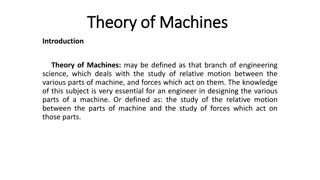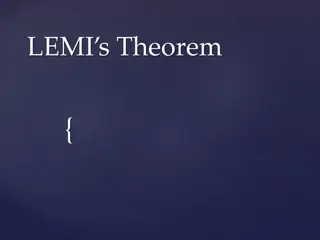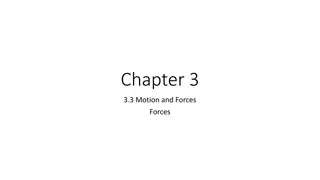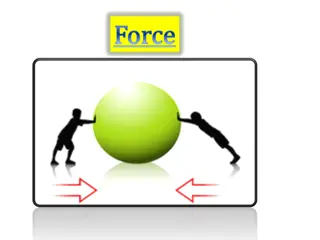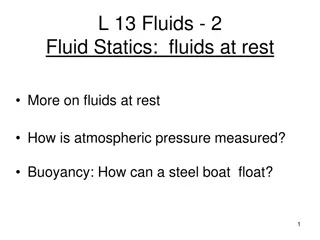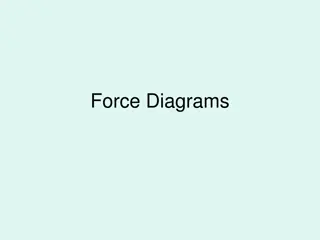Solving Statics Problems: Applications of Forces
In this lesson, we delve into the practical applications of forces in statics, focusing on scenarios involving equilibrium conditions and friction between surfaces. You'll learn how to determine the maximum force before movement occurs, calculate normal reactions, and solve complex problems using force diagrams and mathematical relationships.
Download Presentation

Please find below an Image/Link to download the presentation.
The content on the website is provided AS IS for your information and personal use only. It may not be sold, licensed, or shared on other websites without obtaining consent from the author.If you encounter any issues during the download, it is possible that the publisher has removed the file from their server.
You are allowed to download the files provided on this website for personal or commercial use, subject to the condition that they are used lawfully. All files are the property of their respective owners.
The content on the website is provided AS IS for your information and personal use only. It may not be sold, licensed, or shared on other websites without obtaining consent from the author.
E N D
Presentation Transcript
Applications of Forces A block of mass 3kg rests on a rough horizontal plane. The coefficient of friction between the block and the plane is 0.4. When a horizontal force P N is applied to the block, the block remains in equilibrium. a) Find the value for P for which the equilibrium is limiting b) Find the value of F when P = 8N You can also solve statics problems by using the relationship ? = ?? We have seen before that FMAX is the maximum frictional force possible between two surfaces, and that it will resist any force up to this amount 3g R Remember that the frictional force can be lower than this and still prevent movement F P 3kg In statics, FMAX is reached when a body is in limiting equilibrium, ie) on the point of moving 3g Resolve vertically for R Find FMAX ?( ) ? = ?? ????= ?? It is important to consider which direction the object is about to move as this affects the direction the friction is acting Sub in values with R as positive Sub in values ? 3? = 0 ????= (0.4)(3?) Add 3g Calculate ? = 3? ????= 11.76? So if P = 11.76N, then the block is in limiting equilibrium on the point of moving For part b), if P = 8N then equilibrium is not limiting, and P will be matched by a frictional force of 8N 7C
Applications of Forces Draw a diagram R P You can also solve statics problems by using the relationship ? = ?? Find the normal reaction as we need this for FMAX PSin60 60 F 8kg PCos60 A mass of 8kg rests on a rough horizontal plane. The mass may be modelled as a particle, and the coefficient of friction between the mass and the plane is 0.5. 8g Resolve Vertically ?( ) Find the magnitude of the maximum force PN, which acts on this mass without causing it to move if P acts at an angle of 60 above the horizontal. ? = ?? Sub in values with R as positive ? + ????60 8? = 0 Rearrange to find R in terms of P ? = 8? ????60 ????= 4? 0.5????60 Find FMAX ????= ?? Sub in values ????= (0.5)(8? ????60) Multiply bracket out ????= 4? 0.5????60 7C
Applications of Forces Draw a diagram R P You can also solve statics problems by using the relationship ? = ?? Find the normal reaction as we need this for FMAX PSin60 60 F 8kg PCos60 A mass of 8kg rests on a rough horizontal plane. The mass may be modelled as a particle, and the coefficient of friction between the mass and the plane is 0.5. The horizontal forces will cancel out as the block is in limiting equilibrium 8g Resolve Horizontally ?( ) Find the magnitude of the maximum force PN, which acts on this mass without causing it to move if P acts at an angle of 60 above the horizontal. ? = ?? Sub in values with P as positive ????60 ? = 0 Sub in FMAX ????60 (4? 0.5????60) = 0 ????= 4? 0.5????60 Multiply out the bracket ????60 4? + 0.5????60 = 0 Add 4g ????60 + 0.5????60 = 4? If ? is any greater, the block will start to accelerate. Factorise P on the left side ?(???60 + 0.5???60) = 4? Divide by the bracket If ? is any smaller, then FMAX will be less and hence the block will not be in limiting equilibrium 4? ? = ???60 + 0.5???60 Calculate 7C ? = 42.01?


